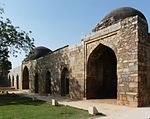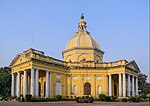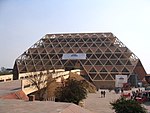
Indian architecture is rooted in the history, culture, and religion of India. Among several architectural styles and traditions, the best-known include the many varieties of Hindu temple architecture and Indo-Islamic architecture, especially Rajput architecture, Mughal architecture, South Indian architecture, and Indo-Saracenic architecture. Early Indian architecture was made from wood, which did not survive due to rotting and instability in the structures. Instead, the earliest existing architecture are made with Indian rock-cut architecture, including many Buddhist, Hindu, and Jain temples.
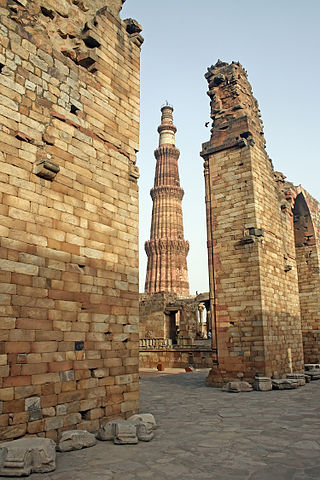
The Qutb Minar complex are monuments and buildings from the Delhi Sultanate at Mehrauli in Delhi, India. Construction of the Qutub Minar "victory tower" in the complex, named after the religious figure Sufi Saint Khwaja Qutbuddin Bakhtiar Kaki, was begun by Qutb-ud-din Aibak, who later became the first Sultan of Delhi of the Mamluk dynasty. It was continued by his successor Iltutmish, and finally completed much later by Firoz Shah Tughlaq, a Sultan of Delhi from the Tughlaq dynasty (1320–1412) in 1368 AD. The Qubbat-ul-Islam Mosque, later corrupted into Quwwat-ul Islam, stands next to the Qutb Minar.
The Qutb Minar, also spelled Qutub Minar and Qutab Minar, is a minaret and victory tower comprising the Qutb complex, which lies at the site of Delhi's oldest fortified city, Lal Kot, founded by the Tomar Rajputs. It is a UNESCO World Heritage Site in the Mehrauli area of South Delhi, India. It was mostly built between 1199 and 1220, contains 399 steps, and is one of the most-frequented heritage spots in the city. Qutab-ud-din Aibak initiated construction of the Qutub Minar, but only managed to finish the first level. Successors continued the construction, and, in 1368, Firuz Shah Tughlaq rebuilt the top parts and added a cupola.

The Agra Fort is a historical fort in the city of Agra, also known as Agra's Red Fort. Mughal emperor Humayun was crowned at this fort in 1530. It was later renovated by the Mughal emperor Akbar from 1565 and the present-day structure was completed in 1573. It served as the main residence of the rulers of the Mughal dynasty until 1638, when the capital was shifted from Agra to Delhi. It was also known as the "Lal-Qila" or "Qila-i-Akbari". Before being captured by the British, the last Indian rulers to have occupied it were the Marathas. In 1983, the Agra fort was inscribed as a UNESCO World Heritage Site because of its importance during Mughal rule. It is about 2.5 kilometers (1.6 mi) northwest of its more famous sister monument, the Taj Mahal. The fort can be more accurately described as a walled city. It was later renovated by Shah Jahan.

Humayun's tomb is the tomb of Mughal emperor, Mirza Nasir al-Din Muhammad commonly known as Humayun situated in Delhi, India. The tomb was commissioned by Humayun's first wife and chief consort, Empress Bega Begum under her patronage in 1558, and designed by Mirak Mirza Ghiyas and his son, Sayyid Muhammad, Persian architects chosen by her. It was the first garden-tomb on the Indian subcontinent, and is located in Nizamuddin East, Delhi, close to the Dina-panah Citadel, also known as Purana Qila, that Humayun found in 1538. It was also the first structure to use red sandstone at such a scale. The tomb was declared a UNESCO World Heritage Site in 1993, and since then has undergone extensive restoration work, which is complete. Besides the main tomb enclosure of Humayun, several smaller monuments dot the pathway leading up to it, from the main entrance in the West, including one that even pre-dates the main tomb itself, by twenty years; it is the tomb complex of Isa Khan Niazi, an Afghan noble in Sher Shah Suri's court of the Suri dynasty, who fought against the Mughals, constructed in 1547 CE.

Mughal architecture is the type of Indo-Islamic architecture developed by the Mughals in the 16th, 17th and 18th centuries throughout the ever-changing extent of their empire in the Indian subcontinent. It developed from the architectural styles of earlier Muslim dynasties in India and from Iranian and Central Asian architectural traditions, particularly Timurid architecture. It also further incorporated and syncretized influences from wider Indian architecture, especially during the reign of Akbar. Mughal buildings have a uniform pattern of structure and character, including large bulbous domes, slender minarets at the corners, massive halls, large vaulted gateways, and delicate ornamentation; examples of the style can be found in modern-day Afghanistan, Bangladesh, India and Pakistan.

Mehrauli is a neighbourhood in South Delhi, Delhi, India. It represents a constituency in the legislative assembly of Delhi. The area is close to Gurugram and next to Vasant Kunj.

Purana Qila is one of the oldest forts in Delhi, India. It was built by the second Mughal Emperor Humayun and Surid Sultan Sher Shah Suri. The fort forms the inner citadel of the city of Dinpanah. It is located near the expansive Pragati Maidan exhibition ground and is separated from Dhyanchand Stadium by Mathura Road, Delhi.

Adham Khan's Tomb is the 16th-century tomb of Adham Khan, a general of the Mughal Emperor Akbar. He was the younger son of Maham Anga, Akbar's wet nurse thus also his foster brother. However, when Adham Khan murdered Akbar’s favourite general Ataga Khan in May 1562, Akbar immediately ordered his execution by defenestration from the ramparts of the Agra Fort.

Lal Kot or Qila Rai Pithora is a fortified complex in present-day Delhi, which includes the Qutb Minar complex. It was constructed in the reign of Rajput Tomar ruler Anangpal Tomar between c. 1052 - c.1060 CE. It is termed as the "First city of Delhi". Remains of the fort walls are scattered across South Delhi, visible in present Saket, Mehrauli around Qutb complex, Sanjay Van, Kishangarh and Vasant Kunj areas.

Indo-Islamic architecture is the architecture of the Indian subcontinent produced by and for Islamic patrons and purposes. Despite an initial Arab presence in Sindh, the development of Indo-Islamic architecture began in earnest with the establishment of Delhi as the capital of the Ghurid dynasty in 1193. Succeeding the Ghurids was the Delhi Sultanate, a series of Central Asian dynasties that consolidated much of North, East, and Central India, and later by the Mughal Empire during the early 16th century. Both of these dynasties introduced Islamic architecture and art styles from West Asia into the Indian subcontinent.

Delhi has been an important political centre of India as the capital of several empires. The recorded history of Delhi begins with the 8th century Tomar Rajput dynasty. It is considered to be a city built, destroyed and rebuilt several times, as outsiders who successfully invaded the Indian subcontinent would ransack the existing capital city in Delhi, and those who came to conquer and stay would be so impressed by the city's strategic location as to make it their capital and rebuild it in their own way.

Salimgarh Fort was built in 1546 AD, in Delhi, in a former island of the Yamuna River, by Salim Shah Suri, son of Sher Shah Suri. There was a pause in Mughal rule when in 1540 AD Sher Shah Suri defeated the Mughal emperor Humayun and established the Sur Empire rule in Delhi. Sur dynasty rule lasted till 1555 AD when Humayun regained his kingdom by defeating Sikander Suri, the last ruler of the dynasty. During the Mughal period, in later years, while building the Red Fort and Shahjahanbad, several Mughal rulers reigned, including Emperor Shahjahan, who is credited with completing Shahjahanabad in 1639 AD had camped at the fort. It is said that Humayun had camped at the fort for three days before launching his successful attack for recapturing Delhi.
Pakistani architecture is intertwined with the architecture of the broader Indian subcontinent. The major architectural styles popular in the past were Temple, Indo-Islamic, Mughal and Indo-Saracenic architecture, all of which have many regional varieties. With the beginning of the Indus civilization around the middle of the 3rd millennium BC, for the first time in the area which encompasses today's Pakistan an advanced urban culture developed with large structural facilities, some of which survive to this day. This was followed by the Gandhara style of Buddhist architecture that borrowed elements from Ancient Greece. These remnants are visible in the Gandhara capital of Taxila.

Siri Fort, in the city of New Delhi, was built during the rule of Alauddin Khalji, second ruler of Khalji Dynasty, of Delhi Sultanate to defend the city from the onslaught of the Mongols. It was the second of the seven cities of medieval Delhi built around 1303, which at present is seen only in ruins with a few remnants due to its poor quality construction as compared to previous fort constructions in India (pictured).

Jahanpanah was the fourth medieval city of Delhi established in 1326–1327 by Muhammad bin Tughlaq of the Delhi Sultanate. To counter the persistent threat of Mongol invasions, Tughlaq constructed the fortified city of Jahanpanah, incorporating the Adilabad Fort, built in the 14th century, along with all the establishments located between Qila Rai Pithora and Siri Fort. Neither the city nor the fort has survived. Many reasons have been offered for such a situation. One of these is exemplified by the idiosyncratic rule of Mohammed bin Tughlaq, who inexplicably decreed the capital to be moved to Daulatabad in the Deccan, only to return to Delhi soon after.

Persian Inscriptions on Indian Monuments is a book written in Persian by Dr Ali Asghar Hekmat E Shirazi and published in 1956 and 1958 and 2013. New edition contains the Persian texts of more than 200 epigraphical inscriptions found on historical monuments in India, many of which are currently listed as national heritage sites or registered as UNESCO world heritage, published in Persian; an English edition is also being printed.
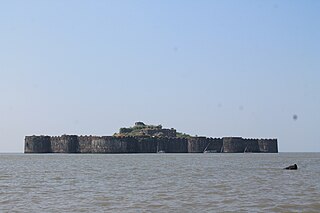
The Deccan sultanates were five early modern kingdoms, namely Bijapur, Golkonda, Ahmadnagar, Bidar, and Berar, which ruled the Deccan Plateau for part of the 15th, and the majority of the 16th–17th centuries. Their architecture was a regional variant of Indo-Islamic architecture, and influenced by the styles of the Delhi Sultanate and later Mughal architecture, but sometimes also influenced from Persia and Central Asia. Hindu temple architecture in the same areas had very different styles.
The following is a timeline of the history of Delhi, including New Delhi. Changes in ruling nation are in bold, with a flag to represent the country where available.



